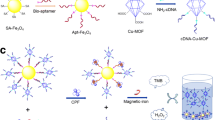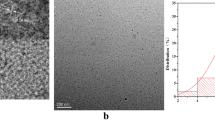Abstract
A fluorometric aptamer-based method is described for sensitive detection of the pesticide acetamiprid. Cationic carbon dots (cCDs) with blue fluorescence were synthesized from cetrimonium bromide (CTAB) by a hydrothermal method. In the presence of the acetamiprid aptamers with a negative charge, the aptamers bind to the surface of the cCDs due to electrostatic attraction. As a result, the fluorescence of the cCDs is quenched partially (the best measurement was done at excitation/emission wavelengths of 360/445 nm). If acetamiprid is added to the above system, the aptamer binds to acetamiprid as a target with strong and specific affinity. Therefore, fluorescence increases proportionally to the acetamiprid concentrations. The aptasensor has a detection limit of 0.3 nM with a dynamic range from 1.6 to 120 nM which reveals that the method is sensitive in comparison to the other techniques. The selectivity of the method towards various pesticides was also studied and found to be adequate. The sensor was applied for the determination of acetamiprid in (spiked) wastewater, tap water, and tomatoes to underpin its practicability.

Cationic CDs (cCDs) were synthesized from cetrimonium bromide by a hydrothermal method. The addition of the negatively charged acetamiprid aptamer to a solution containing cCDs, the cCDs will be coated by the aptamer. This causes the blue fluorescence of the cCDs partially is quenched. If acetamiprid (ACP) is then added, the aptamer will bind to acetamiprid with strong and specific affinity. Hence, fluorescence will be gradually restored.




Similar content being viewed by others
References
Liu Q, Huan J, Dong X, Qian J, Hao N, You T, Mao H, Wang K (2016) Resonance energy transfer from CdTe quantum dots to gold nanorods using MWCNTs/rGO nanoribbons as efficient signal amplifier for fabricating visible-light-driven “on-off-on” photoelectrochemical acetamiprid aptasensor. Sensors Actuators B Chem 235:647–654
Yang Z, Qian J, Yang X, Jiang D, Du X, Wang K, Mao H, Wang k (2015) A facile label-free colorimetric aptasensor for acetamiprid based on the peroxidase-like activity of hemin-functionalized reduced graphene oxide. Biosens Bioelectron 65:39, 46
Verdian A (2018) Apta-nanosensors for detection and quantitative determination of acetamiprid–a pesticide residue in food and environment. Talanta 176:456–464
Xiang L, Tang J (2017) QD-aptamer as a donor for a FRET-based chemosensor and evaluation of affinity between acetamiprid and its aptamer. RSC Adv 7:8332–8337
Kaur R, Gupta V, Christopher A, Bansal P (2015) Potential pathways of pesticide action on erectile function–a contributory factor in male infertility. Asian Pac J Reprod 4:322–330
Babeľová J, Šefčíková Z, Čikoš Š, Špirková A, Kovaříková V, Koppel J, Makarevich AV, Makarevich AV, Fabian D (2017) Exposure to neonicotinoid insecticides induces embryotoxicity in mice and rabbits. Toxicology 392:71–80
Han W, Tian Y, Shen X (2018) Human exposure to neonicotinoid insecticides and the evaluation of their potential toxicity: an overview. Chemosphere 192:59–65
Furusawa N (2015) A green HPLC-PDA technique for detecting Acetamiprid and its metabolite IM-2-1. JACS 1(2):31
Zheng D, Ye Y, Lu F (2016) Determination of indoxacarb, chlorfenapyr and acetamiprid residues in tea by gas chromatography-triple quadrupole mass spectrometry. J Food Saf Food Qual 7:4919
Watanabe E, Iwafune T, Baba K, Kobara Y (2016) Organic solvent-saving sample preparation for systematic residue analysis of Neonicotinoid insecticides in agricultural products using liquid chromatography− diode Array detection. Food Anal Methods 9:245–254
Amelin V, Bol’shakov D, Andoralov A (2017) Determination of neonicotinoid insecticides in natural waters by high-resolution time-of-flight mass spectrometry with direct electrospray ionization of samples. J Anal Chem 72:178–182
Hassan M, Gomes VG, Dehghani A, Ardekani SM (2018) Engineering carbon quantum dots for photomediated theranostics. Nano Res 11(1):1–41
Saberi Z, Rezaei B, Faroukhpour H, Ensafi AA (2018) A fluorometric aptasensor for methamphetamine based on fluorescence resonance energy transfer using cobalt oxyhydroxide nanosheets and carbon dots. Microchim Acta 185:303
Gui W, Zhang J, Chen X, Yu D, Ma Q (2018) N-doped graphene quantum dot@ mesoporous silica nanoparticles modified with hyaluronic acid for fluorescent imaging of tumor cells and drug delivery. Microchim Acta 185:66
Li L, Lai X, Xu X, Li J, Yuan P, Feng J, Wei L, Wei L (2018) Determination of bromate via the chemiluminescence generated in the sulfite and carbon quantum dot system. Microchim Acta 185:136
Shang W, Cai T, Zhang Y, Liu D, Liu S (2018) Facile one pot pyrolysis synthesis of carbon quantum dots and graphene oxide nanomaterials: all carbon hybrids as eco-environmental lubricants for low friction and remarkable wear-resistance. Tribol Int 118:373–380
Xu H, Yan L, Nguyen V, Yu Y, Xu Y (2017) One-step synthesis of nitrogen-doped carbon nanodots for ratiometric pH sensing by femtosecond laser ablation method. Appl Surf Sci 414:238–243
Liu Q, Zhang N, Shi H, Ji W, Yuan W, Hu Q (2018) One-step microwave synthesis of carbon dots for highly sensitive and selective detection of copper ion in aqueous solution. New J Chem 42:3097–3101
Liu X, Wei S, Diao Q, Ma P, Xu L, Xu S, Sun Y, Song D, Wang X (2017) Hydrothermal synthesis of N-doped carbon dots for selective fluorescent sensing and cellular imaging of cobalt (II). Microchim Acta 184:3825–3831
Namdari P, Negahdari B (2017) A. Eatemadi, synthesis, properties and biomedical applications of carbon-based quantum dots: an updated review. Biomed Pharmacother 87:209–222
Chen A, Yang S (2015) Replacing antibodies with aptamers in lateral flow immunoassay. Biosens Bioelectron 71:230–242
Song Y, Xu G, Wei F, Cen Y, Sohail M, Shi M, Xu X, Ma Y, Ma Y, Hu Q (2018) Aptamer-based fluorescent platform for ultrasensitive adenosine detection utilizing Fe3O4 magnetic nanoparticles and silver nanoparticles. Microchim Acta 185:139
Feng C, Dai S, Wang L (2014) Optical aptasensors for quantitative detection of small biomolecules: a review. Biosens Bioelectron 59:64–74
Rhouati A, Catanante G, Nunes G, Hayat A, Marty JL (2016) Label-free aptasensors for the detection of mycotoxins. Sensors 16:2178
Ng S, Lim HS, Ma Q, Gao Z (2016) Optical Aptasensors for adenosine triphosphate. Theranostics 6(10):1683–1702
He J, Liu Y, Fan M, Liu X (2011) Isolation and identification of the DNA aptamer target to acetamiprid. Agric Food Chem 59:1582–1586
Chen H, Wu Y, Yang W, Zhan S, Qiu S, Zhou P (2017) Ultrasensitive and selective detection of isocarbophos pesticide based on target and random ssDNA triggered aggregation of hemin in polar organic solutions. Sensors Actuators B Chem 243:445–453
Motaghi H, Mehrgardi MA, Bouvet P (2017) Carbon dots-AS1411 aptamer nanoconjugate for ultrasensitive spectrofluorometric detection of cancer cells. Sci Rep 7:10513
Yang S, Zhu C, Sun J, He P, Yuan N, Ding J, Ding G, Xie X (2015) Triphenylphosphine modified graphene quantum dots: spectral modulation for full spectrum of visible light with high quantum yield. RSC Adv 5:3334
Barati A, Shamsipur M, Arkan E, Hosseinzadeh L, Abdollahi H (2015) Synthesis of biocompatible and highly photoluminescent nitrogen doped carbon dots from lime: analytical applications and optimization using response surface methodology. Mater Sci Eng C 47:325–332
Qi Y, Xiu F-R, Zheng M, Li B (2016) A simple and rapid chemiluminescence aptasensor for acetamiprid in contaminated samples: sensitivity, selectivity and mechanism. Biosens Bioelectron 83:243–249
Hu W, Chen Q, Li H, Ouyang Q, Zhao J (2016) Fabricating a novel label-free aptasensor for acetamiprid by fluorescence resonance energy transfer between NH2-NaYF4: Yb, ho@ SiO2 and au nanoparticles. Biosens Bioelectron 80:398–404
Lin B, Yu Y, Li R, Cao Y, Guo M (2016) Turn-on sensor for quantification and imaging of acetamiprid residues based on quantum dots functionalized with aptamer. Sensors Actuators B Chem 229:100–109
Abnous K, Danesh NM, Ramezani M, Alibolandi M, LavaeeSeyed P, Taghdisi SM (2017) Aptamer based fluorometric acetamiprid assay using three kinds of nanoparticles for powerful signal amplification. Microchim Acta 184:81–90
Bahreyni A, Yazdian-Robati R, Ramezani M, Abnous K, Taghdisi SM (2018) Fluorometric aptasensing of the neonicotinoid insecticide acetamiprid by using multiple complementary strands and gold nanoparticles. Microchim Acta 185:272
Author information
Authors and Affiliations
Corresponding author
Ethics declarations
The author(s) declare that they have no competing interests.
Additional information
Publisher’s note
Springer Nature remains neutral with regard to jurisdictional claims in published maps and institutional affiliations.
Electronic supplementary material
ESM 1
(DOC 184 kb)
Rights and permissions
About this article
Cite this article
Saberi, Z., Rezaei, B. & Ensafi, A.A. Fluorometric label-free aptasensor for detection of the pesticide acetamiprid by using cationic carbon dots prepared with cetrimonium bromide. Microchim Acta 186, 273 (2019). https://doi.org/10.1007/s00604-019-3378-9
Received:
Accepted:
Published:
DOI: https://doi.org/10.1007/s00604-019-3378-9




